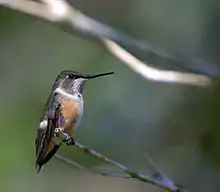Amethyst woodstar
The amethyst woodstar (Calliphlox amethystina) is a species of hummingbird in the family Trochilidae. It is found in most of central, and eastern South America proper, in Argentina, Bolivia, Brazil, Colombia, Ecuador, French Guiana, Guyana, Suriname-(the Guianas), Paraguay, Peru, and Venezuela. The bird's range surrounds the Amazon countries into the Andes foothills and higher elevations of upstream river systems, but is not along the Amazon River proper in the central Amazon Basin, or the central upper Basin; it is in Brazil at the river's outlet, and upstream for about 500 km.
| Amethyst woodstar | |
|---|---|
.jpg.webp) | |
 | |
| male (above) and female (below) | |
| Scientific classification | |
| Kingdom: | Animalia |
| Phylum: | Chordata |
| Class: | Aves |
| Order: | Apodiformes |
| Family: | Trochilidae |
| Genus: | Calliphlox |
| Species: | C. amethystina |
| Binomial name | |
| Calliphlox amethystina Boddaert, 1783 | |
 | |
| Range | |
At 7.5 cm (3 in) and under 3 grams in weight, this is one of the smallest birds in existence.[2] It has a generalist diet of nearby flower nectar and insects in flight.[3] This species is generally poorly understood due to its rarity. Said rarity has also made it difficult to set a concrete conservation status (some even considering it as critical).[4]
There is a hypothesized hybrid between this species and Chlorostilbon aureoventris dubbed Calliphlox iridescens Gould.[5]
Taxonomy
The amethyst woodstar was described by the French polymath Georges-Louis Leclerc, Comte de Buffon in 1781 in his Histoire Naturelle des Oiseaux.[6] The bird was also illustrated in a hand-coloured plate engraved by François-Nicolas Martinet in the Planches Enluminées D'Histoire Naturelle which was produced under the supervision of Edme-Louis Daubenton to accompany Buffon's text.[7] Neither the plate caption nor Buffon's description included a scientific name but in 1783 the Dutch naturalist Pieter Boddaert coined the binomial name Trochilus amethystinus in his catalogue of the Planches Enluminées.[8] The type locality is Cayenne in French Guiana.[9] The amethyst woodstar is now placed in the genus Calliphlox that was introduced by the German zoologist Friedrich Boie in 1831.[10][11] The species is monotypic.[11] The generic name is derived from the Ancient Greek kalliphlox meaning "beautifully blazing". The specific epithet is Latin for "amethyst-coloured".[12]
Habitat
The amethyst woodstar's natural habitats are subtropical or tropical moist lowland forest and subtropical or tropical moist montane forest.
References
- BirdLife International (2012). "Calliphlox amethystina". IUCN Red List of Threatened Species. 2012. Retrieved 26 November 2013.CS1 maint: ref=harv (link)
- Wood, The Guinness Book of Animal Facts and Feats. Sterling Pub Co Inc. (1983), ISBN 978-0-85112-235-9
- "Amethyst Woodstar - Introduction | Neotropical Birds Online". neotropical.birds.cornell.edu. Retrieved 2019-05-24.
- Graves, Gary. "EL PICAFLOR AMATISTA (Calliphlox amethystina) EN LA ARGENTINA (THE AMETHYST WOODSTAR (Calliphlox amethystina) IN ARGENTINA)" (PDF). Revista Nuestras Aves. 53: 39–41.
- Graves, Gary (June 1999). "Diagnoses of hybrid hummingbirds (Aves : Trochilidae). 7. Probable parentage of Calliphlox iridescens Gould, 1860". Proceedings of the Biological Society of Washington. 112 (2): 443–450. hdl:10088/12855.
- Buffon, Georges-Louis Leclerc de (1781). "L'améthiste". Histoire Naturelle des Oiseaux (in French). Volume 11. Paris: De L'Imprimerie Royale. pp. 20–21.
- Buffon, Georges-Louis Leclerc de; Martinet, François-Nicolas; Daubenton, Edme-Louis; Daubenton, Louis-Jean-Marie (1765–1783). "Petit oiseau-mouche à queue fourchue, de Cayenne". Planches Enluminées D'Histoire Naturelle. Volume 7. Paris: De L'Imprimerie Royale. Plate 672 Fig. 1.
- Boddaert, Pieter (1783). Table des planches enluminéez d'histoire naturelle de M. D'Aubenton : avec les denominations de M.M. de Buffon, Brisson, Edwards, Linnaeus et Latham, precedé d'une notice des principaux ouvrages zoologiques enluminés (in French). Utrecht. p. 41, Number 672 Fig. 1.
- Peters, James Lee, ed. (1945). Check-list of Birds of the World. Volume 5. Cambridge, Massachusetts: Harvard University Press. p. 135.
- Boie, Friedrich (1831). "Bemerkungen über Species und einige ornithologische Familien und Sippen". Isis von Oken (in German). Cols 538–548 [544].
- Gill, Frank; Donsker, David, eds. (2019). "Hummingbirds". World Bird List Version 9.2. International Ornithologists' Union. Retrieved 22 July 2019.
- Jobling, James A. (2010). The Helm Dictionary of Scientific Bird Names. London: Christopher Helm. pp. 45, 85. ISBN 978-1-4081-2501-4.
External links
| Wikimedia Commons has media related to Calliphlox amethystina. |
| Wikispecies has information related to Calliphlox amethystina. |
- Amethyst Woodstar videos on the Internet Bird Collection
- Amethyst Woodstar photo gallery VIREO Photo-High Res
- Photo-High Res; Article ib.usp.br–"Trochilidae"

